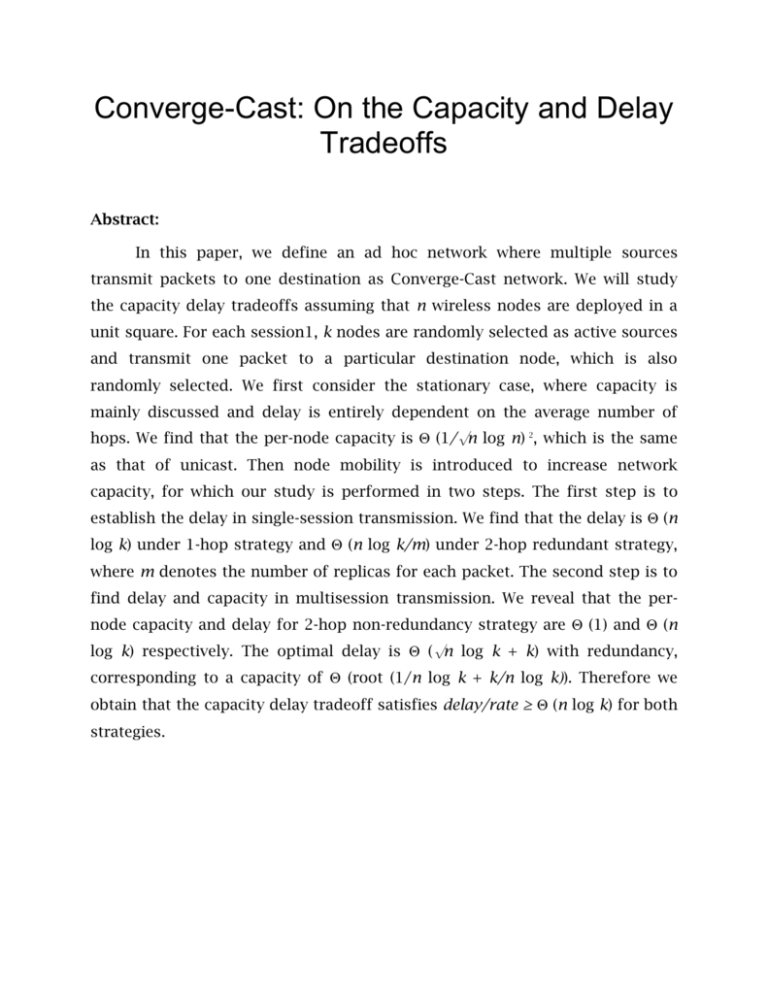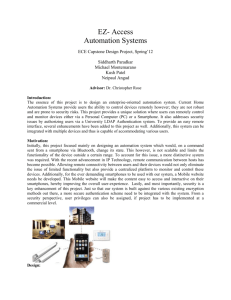Abstract - Chennaisunday.com
advertisement

Converge-Cast: On the Capacity and Delay Tradeoffs Abstract: In this paper, we define an ad hoc network where multiple sources transmit packets to one destination as Converge-Cast network. We will study the capacity delay tradeoffs assuming that n wireless nodes are deployed in a unit square. For each session1, k nodes are randomly selected as active sources and transmit one packet to a particular destination node, which is also randomly selected. We first consider the stationary case, where capacity is mainly discussed and delay is entirely dependent on the average number of hops. We find that the per-node capacity is Θ (1/√n log n) 2, which is the same as that of unicast. Then node mobility is introduced to increase network capacity, for which our study is performed in two steps. The first step is to establish the delay in single-session transmission. We find that the delay is Θ (n log k) under 1-hop strategy and Θ (n log k/m) under 2-hop redundant strategy, where m denotes the number of replicas for each packet. The second step is to find delay and capacity in multisession transmission. We reveal that the pernode capacity and delay for 2-hop non-redundancy strategy are Θ (1) and Θ (n log k) respectively. The optimal delay is Θ (√n log k + k) with redundancy, corresponding to a capacity of Θ (root (1/n log k + k/n log k)). Therefore we obtain that the capacity delay tradeoff satisfies delay/rate ≥ Θ (n log k) for both strategies. Architecture: Algorithm: 2-hop algorithm: In 2-hop algorithm, there are two types of transmissions: SourceRelay(S-R) transmission and Relay-Destination(R-D) transmission. Thus, when a particularly pair is selected, there will be two conditions: S-R pair or R-D pair. 1. If node Nsend contains packet P in its relaying pool to be sent to Nreceive, and Nsend is in the same cell as Nreceive, we call Nsend and Nreceive a R-D pair. 2. If node Nsend does not contain packet P in its relaying pool to be sent to Nreceive, while node Nreceive does not contain packet P in its relaying pool to be sent to Nsend, and Nsend is in the same cell as Nreceive, we call Nsend and Nreceive a S-R pair. Existing System: A single session cannot make full use of the network capacity due to the overhead of the root in the spanning tree. The second difference is the definition of throughput. In multicast scheme, all the k destinations in a session receive the same packet, and only one packet can be treated as valid and the other k Θ (1) packets are redundancies. Search the optimal capacity delay tradeoff and identify the limiting factors of the existing scheduling schemes in MANETs. Disadvantage: 1. Limiting factors. 2. Low redundancy. Proposed System: In this paper, we define an ad hoc network where multiple sources transmit packets to one destination as Converge-Cast network. We will study the capacity delay tradeoffs assuming that n wireless nodes are deployed in a unit square. For each session1, k nodes are randomly selected as active sources and transmit one packet to a particular destination node, which is also randomly selected. Advantages: 1. High redundancy. 2. Reduce the Delay. 3. High Network Capacity. 4. Many – One Transmission 5. Nodes are randomly selected. 6. Random Walk Pattern. 7. Multi-hop Transmission. Modules: 1. Network Model Converge-Cast network has a very similar configuration with multicast network in that the information dissemination can both be modeled as a spanning tree. Yet there still exist some differences. The first difference is the transmission direction. Secondly, k sources transmit different packets to their destination in Converge-Cast network, while k destinations receive the same packets duplicated from the only source in multicast network. In the Converge-Cast network, all the packets are entirely different and indispensable so that they are forced to reach the destination node. Thirdly, there is more interference in Converge-Cast network than multicast network when we use large redundancy to reduce the delay. 2. Buffer Model (i) The sending pool is for packets that are sampled by the node itself. When a new session starts, a new packet is produced and duplicated m times if the node is selected as source. Then if the node is permitted to transmit its packet, it will randomly choose a packet in the pool and delete it after the transmission. (ii) The relaying pool is for packets that are sampled by other node and will be sent to other destinations. When this node Nsend meets another node Nreceive which is the destination of one of the packets P in the relaying pool, and this pair is selected according to the scheduling strategy, the packet P will be delivered to the receiving pool in node Nreceive. Then the packet P will be deleted from the relaying pool in node Nsend.. (iii) The receiving pool is for packets that are designated for it. When this node Nreceive meets another node Nsend which contains a packet P whose destination ID is Nreceive, and this pair is selected according to the scheduling strategy, the packet P will be delivered to the receiving pool in node Nreceive. And then the packet P will be deleted from the relaying pool in node Nsend. 3. Delay, Capacity and Redundancy When all the k packets of a same session have reached the destination, the delay will be calculated as the difference between the time when the last packet reaches the destination and the time when the packet is sampled. (Notice that k packets’ birth times are the same.) Next the total capacity of the network is defined as the maximum average total data rate, which disregards the amount of redundancy in each time slot. Note that an upper bound of capacity exists to guarantee the stability of the network. Redundancy helps reduce the delay by providing greater chances for the destination to catch its packet. System Specification HARDWARE & SOFTWARE REQUIREMENTS: HARDWARE REQUIREMENTS: System : Pentium IV 2.4 GHz. Hard Disk : 40 GB. Floppy Drive : 1.44 Mb. Monitor : 15 VGA Color. Mouse : Logitech. Ram : 512 MB. SOFTWARE REQUIREMENTS: Operating system : Windows XP Professional. Coding Language : C#.NET







